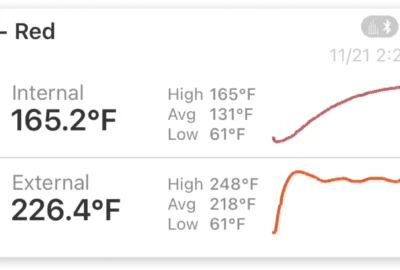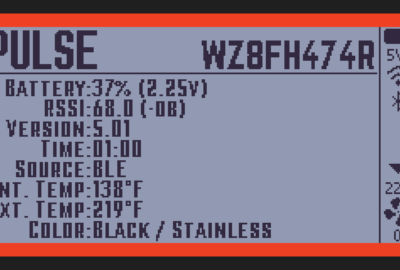Using your FireBoard
Is 350 Really 350? Testing your oven with a FireBoard
Have you ever wondered if the thermostat that controls your oven’s temperature is off? Wouldn’t it be nice to know? Cooking at the wrong temperature is obviously counterproductive. Results can range from radically over or undercooked food to being slightly off by a few degrees which can still affect texture and flavor. What follows is an easy way to prove your oven’s controls are accurate using a FireBoard 2.

Testing an oven’s accuracy with a FireBoard.
Reproducible Results
Naturally accurate temperatures will yield the cook making the dish exactly what the recipe’s creator had intended…and if you are authoring your own recipe, you want to make sure that your instructions are spot on for reproducible results.
Method
You will need an accurate, trusted, calibrated thermometer. If you are going through with this test, you will want to use an accurate thermometer like a FireBoard 2 or Spark. For example, the Spark has a NIST traceable calibration certificate. View our post about FireBoard’s commitment to accuracy and how they follow this standard.

To test the temperature accuracy of your oven you will need a FireBoard or Spark, ambient temperature probe and a pot clip or rack clip to keep the probe measuring the air, not the metal inside the oven.
Probe placement will have a significant effect. Place the probe in the center of the oven space ensuring that the probe is not touching racks or the walls of the inside of the oven. This could result in an incorrect reading. Try to pick a spot that can easily located for future testing. For this test a FireBoard pot clip was used to suspend the ambient probe from the center rack.

The standard grill grate clip did not fit the test oven’s rack, however the pot clip worked out nicely. This versatile FireBoard accessory assists in rigging probes to take measurements without interference from nearby objects.
With convection off, readings were taken 60 minutes past the time the ovennachieved the set temperature. This resulted in modest but consistent temperature fluctuations. A sine wave can be observed of the three test temperatures in the session chart in the FireBoard app. This proves that the oven tested was cycling in an appropriate manner. When the set temperature is reached the heating element turns off until it the temperature dips down a bit and then the oven kicks the heat on again.

Testing three different oven settings, sessions captured from the FireBoard app.
Temperatures were close, but deviations were found at all three temperatures. The lowest temperature setting of the oven, 170ºF, yielded an average of 175.6ºF. While the oven’s setting of 350ºF averaged a slightly lower reading of 341.8ºF and with some similarity 450ºF averaged 435.9ºF

For 170ºF the tested oven heated an average 175.6ºF for over an hour.
The Results
170ºF: +5.6ºF 350: -8.2ºF 450: -14.1ºF The oven tested would use the following correct setting of 360ºF in place of 350ºF and 465ºF in place of 450ºF. Since 170ºF is this oven’s lowest temperature setting it is not possible to correct it any lower–at least without offsetting the entire range.

For 350ºF the tested oven heated an average 341.8ºF for over an hour.

For 450ºF the tested oven heated an average 435.9ºF for over an hour.
Conclusion
Our test results yielded a non-linear delta. Meaning that all three temperature differences were not the same amount over or under the oven’s set temperature. If the test results yielded a consistent difference, this could be an easy fix, as ovens, such as the Maytag tested here can be calibrated by the end user. (i.e. the oven is displaying 20 degrees warmer than actual measured temperature, you would off set this by adding 20 degrees of offset). These adjustments will vary by manufacturer.
Putting this information into action, I have been using these adjusted temp settings and have enjoyed the results. My favorite frozen pizza, that I baked at 456ºF instead of the the 450ºF on the box has never tasted better! I plan to log more differences, testing my commonly temp settings to build a compensation “cheat sheet”. Stay Tuned!









Leave a reply